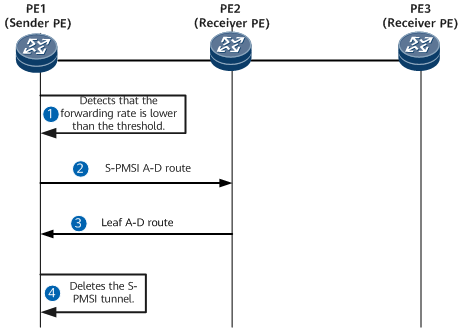Switchback from an S-PMSI Tunnel to the I-PMSI Tunnel
After multicast traffic is switched to an S-PMSI tunnel, the sender PE automatically starts the switchback timer if the traffic forwarding rate is lower than a specified threshold. Figure 1 shows the switchback process. PE1 is the sender PE, and PE2 and PE3 are receiver PEs. PE2 has receivers in the connected VPN, meaning that some users are in the (S, G) corresponding to a received multicast packet, whereas PE3 has no receivers in the connected VPN.
Table 1 describes the switchback process.
Step |
Device |
Description |
|---|---|---|
1 |
PE1 |
When PE1 detects that the forwarding rate of multicast traffic is lower than the threshold, it starts the switchback timer. Before the timer expires:
|
2 |
PE1 |
PE1 sends an S-PMSI A-D route to PE2, instructing PE2 to withdraw the bindings between multicast entries and the S-PMSI tunnel. |
3 |
PE2 |
After receiving the S-PMSI A-D route, PE2 withdraws the bindings between multicast entries and the S-PMSI tunnel, and then replies with a Leaf A-D route. |
4 |
PE2 |
PE1 deletes the S-PMSI tunnel after waiting for a specified period of time. |
